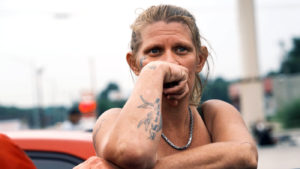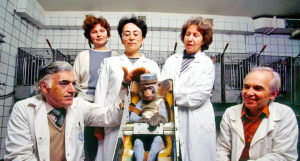“We are going to usher in a new day in the treatment of psychiatric diagnoses and brain health disorders.”
Rob Barrow is the CEO of MindMed: a leader in a new species of pharmaceutical firm. These companies, described as “corporadelic”, are aiming to change mental health — and maybe the world — through psychedelic drugs.
Barrow was the opening speaker at the PSYCH Symposium, held recently in the National Gallery. The agenda: “to connect and collaborate”, and to “expedite access” to “psychedelic healthcare” across Europe. The wider mission is an old Sixties dream — brotherhood, connection to nature — repackaged for a new age of all-powerful corporations and philanthropists.
These are boom times for psychedelics. Celebrity endorsements, Netflix documentaries, and all-star conferences abound. In recent weeks we’ve seen The New York Times and the BBC broadcast stories of veterans dissolving PTSD in MDMA, and psilocybin’s apparent (and, it seems, swiftly-discredited) capacity to “free up the depressed brain”.
Maybe the most extraordinary moment, though, was the Psychedelics House of Davos, featuring a World Economic Forum-sponsored panel: “shamanic investing” expert Silvia Benito, Deepak Chopra, and the Countess Amanda Feilding. Feilding’s Beckley Foundation has fronted her quest since the Sixties to rehabilitate psychedelics — LSD is her favourite — and, curiously, the ancient art of trepanning.
It’s been a strange turnaround. Criminalised and forced underground since 1970, psychedelics and related drugs have been found, by a a growing number of clinical trials, useful in treating mainly psychic ills, including depression, PTSD, anxiety, and addiction. The “peak states” furnished by LSD, psilocybin (the active ingredient in magic mushrooms), MDMA, ketamine, and others — combined with pre- and post-session therapies — can help ease chronic distress. Johns Hopkins studies of psilocybin for end-of-life anxiety, depression, and smoking cessation, for instance, indicate rough efficacy rates of 85%, 75% and 80%, respectively — although their sample sizes were not large or diverse, and their results have not yet been replicated.
Establishing efficacy in trials according to a gold standard of evidence is difficult. Long-term follow-ups are scant and a host of concerning side-effects — re-traumatisation, debilitating changes in visual processing, strokes — are under-explored. COMPASS Pathways’ Phase 2b trial of psilocybin for depression indicated a red flag of suicidal thinking among their patients, prompting huge collapses in the share value of psychedelic firms.
Joining these difficulties are a host of barriers faced by those who want to conduct research on psychedelics. “The Science” is always political, as Covid-19 showed in spades. Psychedelics are researched in an uphill, pragmatic battle against anti-drug prejudice. Britain remains sclerotic and authoritarian on drug policy, as revealed by our new culture war-driven push to persecute “middle class cocaine users” and black-mark their passports. These rules are reified in institutional obstacles to further research (some of them bizarre), which a UK campaign led by Crispin Blunt MP is attempting to reform. Similarly Byzantine practices afflict researchers in the United States. Research must therefore be conducted alongside a push to change attitudes, convince committees, and win a PR war.
The response of psychedelics firms, backers, and some scientists has been to hype their products. Story-hungry media and a searching mental health sector have been willing enablers. We see studies from top institutions suggesting psychedelics can “decrease political authoritarianism”, help combat climate change, or “navigate a path to peace” in Palestine. A recent “population study” suggested psychedelics “lower the odds of crime”, with an “association” observed between peyote use and decreased “motor vehicle theft”. In particular, a famous (and flawed) chart by ex-Drug Tsar Professor David Nutt showed harms from LSD and magic mushrooms as near-zero, with the results replicated in downstream “drug information” and “harm reduction” resources.
The corporadelic movement is playing “the establishment game from inside the establishment”, Countess Feilding said at the Symposium. “Use the light of science to destigmatise and rehabilitate psychedelics.” This rhetorical approach has been dubbed the “Trojan Horse”, with medico-scientific corroboration a vessel for the larger mission.
The missionaries dwell in a broad church. Consider the Multidisciplinary Association for Psychedelic Studies, or MAPS, and its founder Rick Doblin. Funded by and collaborating with corporadelic firms, MAPS is in Phase-3 studies into MDMA for PTSD, in particular for veterans: a group bound to elicit sympathy from the conservatively-minded. “We don’t actually do science,” Doblin said. “We do political science.”
He foresees that psychedelic therapy, and an envisioned network of “thousands of clinics” by 2035, will democratise “the sense of connection, not just the idea of it, but the felt experience of it”.
“It is inevitable that in hyping things up too much, risks can arise”, Countess Feilding clarified via email. “On the other hand, it seems vitally important to establish if psychedelics have a major part to play in the survival of Homo sapiens and in improving our health, happiness, and outlook.”
But today’s psych-elites don’t seem particularly interested in democracy: they are drawn from Silicon Valley, Burning Man bros, billionaires, and California narcissists. A “market opportunity of £1.8 billion by 2026” remains for the taking, Symposium attendees were told. Billionaires like Peter Thiel, venture capital, hedge funds, Google, and the owner of GoDaddy have piled into psychedelic medicine; dozens of new firms with names like Eleusis, Awakn, Field Trip and MindCure have appeared, all decked with white-sheen websites and evangelical web copy. And the safer psychedelic retreats currently cost thousands of dollars, and may well stay that way.
“I believe loving money is one of the greatest gifts you can give humanity at this time,” said Azrya Bequer, one half of a husband-and-wife duo behind BEQOMING, an outfit earmarked “to serve the 0.1% of the wealthiest people in the world to start making better decisions for our planet and our future generations” — through facilitated ayahuasca ceremonies.
Why now? Psychiatry is in crisis, commentators observe: in total contrast to the advances of physical medicine, and despite tens of billions of dollars invested in treatments and research, outcomes remain broadly stagnant. It is a field in search of a silver bullet.
But squaring the circle of the world “out there” has been psychedelia’s perennial problem. “It’s all in the mind, ya know,” George Harrison’s acid cartoon blurbed in 1968’s Yellow Submarine, to the trumpets of All You Need Is Love. The cost-of-living crisis, inequality, institutional decay — the more material drivers of our distress — received little mention at the Symposium. There was talk of trauma, the inner healer, the true self. Or, for pharma firms profiting from a brain-centric, diagnostic view of misery, there is “chemical imbalance” and “brain disorders”, leveraged by overstretched references to “neuroplasticity” and pretty pictures of brain scans. Even the Department of Defence is directing $26.9 million towards novel psychedelics for veteran PTSD, whose battle scars they reduce to a “neurophysiological dysfunction”.
MindMed’s former CEO, JR Rahn — now CEO of a “People-Powered Pharma” outfit called LOVE Inc. — put it this way: “Forty percent of the country is suffering — that’s a big, big market.”
That market is greedy. Reportedly in keeping with the FDA’s regulatory requirements, plans are in place, in time, for MAPS to administer MDMA to children as young as seven. “The sooner you treat people for their trauma, the more benefits when you come to talk about insurance coverage and all,” Doblin said. “The more lifetime benefits there are, the more suffering you avoid.”
It’s tricky territory. A psychoactive as powerful as MDMA would seem precisely contraindicated for children, whose developing brains may render them susceptible to long-term changes and dysregulations. Doblin is firm and provocative. “The prohibitionist argument leaps from problems that can be caused by daily or frequent use of marijuana, or other drugs, to arguments for abstinence”, he said over email. “Daily use of marijuana in high school can be problematic but that doesn’t mean the message to adolescents should be to never use marijuana.
“For adolescent patients with PTSD, their brains are already warped by their PTSD, so not using MDMA to protect their brains doesn’t make sense”, he said.
The mission is not without its own traumas, however. Strikingly, at least four participants in MAPS’ MDMA trials experienced significant deteriorations in their wellbeing that were neither chased up nor reported in their much-vaunted paper, published to mass media attention in Nature. Across psychedelic culture, victims of sexual assault and rape claim they have been told to keep silent to avoid drawing stigma to the Mission.
No psychedelic drug is yet approved by regulators, though MDMA stands at the penultimate Phase 3 stage. More banal realities can be stubborn. Despite complacent claims, including from Professor Nutt last month, that psilocybin is “the most effective antidepressant” — and “we don’t need [controlled trials]” — an Imperial College head-to-head of psilocybin versus an SSRI indicated no significant difference, even after a six month follow up. Press teams and media downstream — even The Daily Mail — spun these results in a more sympathetic tone: that “psilocybin performs as well as antidepressant”. Brought to trials desperate for help — and inflated by PR pumped by research departments about “brain resets” — the patient may experience striking collapses in mood as mushroom euphoria dissipates and depression returns, or if the promised mystical experience fails to manifest.
These are just some of the under-explored problems with “therapy on acid”. Patients are also vulnerable to hyper-suggestibility, sexual abuse, exploitation, and risks of guru complexes among therapists, who can programme their clients with their own worldviews. These issues were rarely mentioned at the Symposium. Reportedly contacted by representatives in Rwanda, Doblin has elsewhere spoken of seeking to dissolve the animosities of Hutus and Tutsis with MDMA. A vague outfit called Unlimited Sciences is fundraising to give ayahuasca to Saudi refugees, for all of whom these bioethical issues are likely aggravated.
In the “Great Psychedelic Craze” of the Sixties, it was believed that LSD and cannabis could create a revolution. Draped in white robes and beads, Dr Timothy Leary told reporters that “the kids who take LSD aren’t going to fight your wars” or “join your corporations”. Looking around the Symposium was to see the death of a dream. Far from overturning power structures, psychedelic utopianism has been captured by the elite.
We listened to Christian Angermayer, the billionaire “Prince of Psychedelia”, who says he “finally understood Bitcoin” after his first psilocybin trip, and has since tattooed the molecule on his arm. He compared his therapists to shamans, drawing a straight line between the apocryphal drug cults of early Christianity and “ancient Egypt”. Angermayer reassured investors of market deteriorations in guru-like tones: “The market is a cycle like life is a cycle … as a company, if you are fully-financed, you almost have to say: okay, ignore the stock market, it does not contribute to your mental health.”
Just as mindfulness became McMindfulness, psychedelics has become McPsychedelics. The transition has not been universally applauded: two senior psychedelic figures described crying at the Symposium. “We thought we were getting Woodstock, but we’re getting Prozac Nation 2.0,” said Jamie Wheal, who was prophetic commentator on the psychedelic scene in 2019.
“How can we compete with this?”, asked Lauren Katalinich of the UK Psychedelics Society, gesturing woefully towards a Symposium room of grey fabric and black suits. Capital does as capital will. In its quest for new and fruitful markets to carve, it has gone from without to deeper within, and plumbed the fathoms of inner mind. Corporadelic firms post marketing photos of misattributed “shamans” on Twitter; “mystical experience”, a predictor for depression, sells. There is perhaps no psychedelic feature that couldn’t be captured and marketed: nominally-radical notions, like encountering hyper-realistic entities and God Himself on DMT, become news copy and advertisements to entice clients.
At its height in the Sixties, the Great Psychedelic Craze believed it could levitate the Pentagon through sheer “vibration”. For the Second Great Craze, the world of “net zero trauma” is its infinity point — where the trip is heading is anybody’s guess. Utopia translates as “no place”.
Disclaimer
Some of the posts we share are controversial and we do not necessarily agree with them in the whole extend. Sometimes we agree with the content or part of it but we do not agree with the narration or language. Nevertheless we find them somehow interesting, valuable and/or informative or we share them, because we strongly believe in freedom of speech, free press and journalism. We strongly encourage you to have a critical approach to all the content, do your own research and analysis to build your own opinion.
We would be glad to have your feedback.
Source: UnHerd Read the original article here: https://unherd.com









